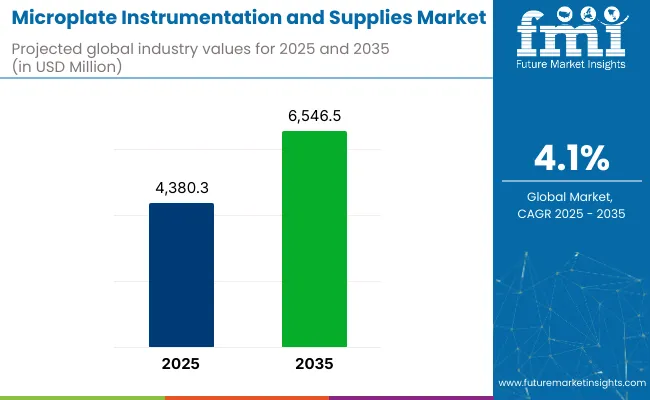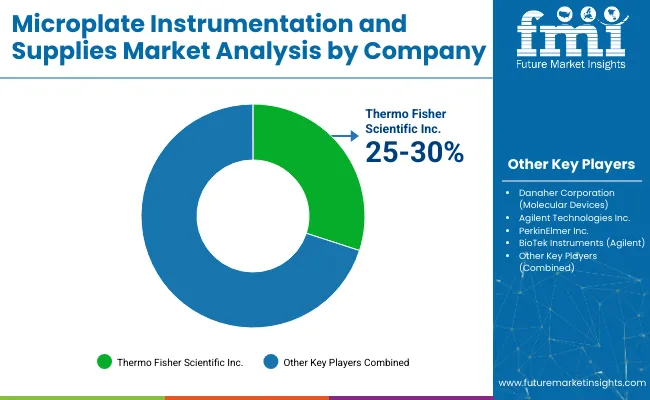The global microplate instrumentation and supplies market is projected to grow from USD 4,380.3 million in 2025 to USD 6,546.5 million by 2035, reflecting a 4.1% CAGR. The expansion is being driven by growth in life-sciences research funding, diagnostics adoption, and automation in laboratories.
In early 2025, Byonoy introduced the Luminescence 96 Automate, a luminometer designed for integration into liquid-handling decks. According to Dr. Yousef Narziriadeh, CEO and Head of R&D at Byonoy, the product “marks a significant step in meeting the growing demand for on deck plate readers tailored to diverse detection methods”.
The device offers seamless compatibility with robotic platforms and incorporates 96 sensitive silicon photomultipliers achieving sensitivity down to 100 fmol ATP per well, while limiting cross-talk below 0.7 × 10⁻⁶. These design features facilitate workflow consolidation and bench space savings.
Multimode readers have become a staple across biotech and pharma labs. BMG LABTECH has noted that multimode microplate readers-capable of absorbance, fluorescence, and luminescence detection-provide efficient assay multiplexing and space optimization. Applications such as ELISA, nucleic acid quantitation, and cell assays consistently benefit from these integrated platforms.
Adoption of compact single-mode luminometers has accelerated as laboratories seek flexible instrumentation. The Luminescence 96 standalone unit was highlighted by News Medical as “the first plate reader to implement highly sensitive silicon photomultipliers,” with an exceptional eight-decade dynamic range and compact footprint.

| Metric | Value |
|---|---|
| Market Size in 2025 | USD 4,380.3 million |
| Projected Market Size in 2035 | USD 6,546.5 million |
| CAGR (2025 to 2035) | 4.1% |
Collaborative validation has further driven trust in these systems. A partnership between Byonoy and Eppendorf, cited in News Medical, showcased integration with epMotion liquid handlers and achievement of accurate protein and bacterial assay readings after SLAS23 demonstrations. Dr. Josef Lott, Product Manager for Automated Liquid Handling at Eppendorf, confirmed that “integrating Byonoy’s compact plate readers into our epMotion system has raised precision and efficiency standards in research workflows”.
In 2025, the market was driven by government-backed research funding, especially in genomics and drug discovery. Academic and commercial labs in North America and Europe have accelerated investments in automated workflows, further propelling demand for integrated microplate solutions.
Challenges remain in assay standardization, plate reader calibration, and compatibility across platforms. However, industry efforts are under way to align instruments with ISO and GLP testing protocols, and ensure modular scaling.
Over the decade, the industry is expected to prioritize compact, deck-integrated plate readers, and multifunctional systems suitable for both high-throughput screening and smaller lab setups. Focus is likely to shift toward improved reagent assay kits, interoperability standards, and validation tools to support the projected market expansion.
Microplate readers are estimated to account for approximately 46% of the global microplate instrumentation and supplies market share in 2025 and are projected to grow at a CAGR of 4.3% through 2035. These devices are integral to laboratory workflows in pharmaceuticals, biotechnology, and clinical diagnostics for absorbance, fluorescence, and luminescence-based assays.
As laboratories increasingly adopt multi-mode readers for versatile assay formats-including ELISA, DNA quantification, and enzyme activity tests-manufacturers continue to enhance spectral resolution, plate compatibility (96-, 384-, and 1536-well), and automation features. Growth is further supported by the integration of data management software and IoT-enabled platforms for real-time monitoring and remote analysis.
The pharmaceutical sector is projected to hold approximately 38% of the global microplate instrumentation and supplies market share in 2025 and is expected to grow at a CAGR of 4.2% through 2035. High-throughput screening (HTS), lead optimization, and ADME-Tox testing all depend on reliable and scalable microplate-based systems.
The push for accelerated drug development timelines, combined with expanding biologics and personalized medicine pipelines, is driving demand for precision microplate readers, dispensers, and washers. Pharmaceutical companies and CROs across North America, Europe, and parts of Asia-Pacific continue to invest in fully automated microplate platforms integrated with robotic arms and AI-based data analysis tools to streamline workflow efficiency and ensure reproducibility. As global R&D spending rises, the pharmaceutical segment remains the core growth engine for the microplate instrumentation market.
High Initial Investment and Maintenance Costs
Microplate furniture requires a hefty initial investment, involving automated liquid handling systems, readers and software integration for plates. In addition, the on-going maintenance and calibrations are costly. This can be prohibitive for smaller laboratories, research institutions that do not have resources to support such expenses relatively soon after making an initial investment
Regulatory Compliance and Standardization
The market has to comply with strict regulations. Standards include Good Laboratory Practice (GLP) as well as conformation to the Food and Drug Administration (FDA) and European Medicines Agency (EMA). Providing consistency in test results and meeting constantly evolving guidelines are challenges for manufacturers in the sector and users.
Growing Demand for High-Throughput Screening
In the new drug discovery, genomics, and proteomics research market, there is a growing need for high-throughput screening. Microplate furniture is a key component in speeding up laboratory work as well as cutting the costs of experiments.
Advancements in Automation and Digital Integration
The integration of AI-governed analytics, cloud-based data management and automation of sample handling all the way will save money, time while reducing human error. These innovations are pushing the adoption of microplates into pharmaceuticals, biotechnology and clinical research sectors.

Microplate Instrumentation and Supplies Market for the United States market is developing rapidly as high-throughput screening in laboratories and automatic operation both occur. Pharmaceutical corporations and the biotech industry are making it widely accessible wherever there is necessity to ensure high quality without going through production goals.
| Country | CAGR (2025 to 2035) |
|---|---|
| United States | 4.2% |
United Kingdom Microplate Instrumentation and Supplies Market is enlarging as research institutions and diagnostic centers call for top-rate laboratory solutions. The trend towards heavier investment in life science and healthcare research is creating market pull. Major laboratory equipment manufacturers located in the nation is another factor which is helping to sustain steady growth.
| Country | CAGR (2025 to 2035) |
|---|---|
| United Kingdom | 4.0% |
The European Union is benefiting, its market for microplate instrumentation and supplies meriting no less than praise just because it has been advanced here and there by some advances in laboratory automation and diagnostic precision. Extending government funds into biomedical research is another factor building broad market foundations.
| Country | CAGR (2025 to 2035) |
|---|---|
| European Union | 4.1% |
While hanging bending rim plates (I believe is only a dealer and not so much designer of these devices) also still happen in South Korea, the Microplate Instrumentation and Supplies Market must owe its rapid growth to rising life sciences research and development activities pipeline. At the same time, the country's emphasis on high-quality innovative diagnostic solutions has been scaring up demand.
| Country | CAGR (2025 to 2035) |
|---|---|
| South Korea | 4.3% |

he development of laboratory automation, increasing demand for high throughput screening, and the expansion of uses in drug discovery as well as diagnosis development SLC Microplate Instrumentation and Supplies market continue to increase
The accurate and efficient analyses that researchers demand more and more is the reason why microplate readers, washers, dispensers are increasingly important. The company is directing investment towards innovative technologies, ranging from automation handling systems with advanced detection methods to improve workflow efficiencies, accuracy of data and the ever changing to meet the needs.
The overall market size for Microplate Instrumentation and Supplies market was USD 4,380.3 million in 2025.
The Microplate Instrumentation and Supplies market is expected to reach USD 6,546.5 million in 2035.
The demand for microplate instrumentation and supplies will rise due to increasing biomedical research, expanding drug discovery, automation in laboratories, and growing diagnostic applications, supported by advancements in microplate technologies and higher healthcare investments.
The top 5 countries which drives the development of Microplate Instrumentation and Supplies market are USA, European Union, Japan, South Korea and UK.
Microplate Readers demand supplier to command significant share over the assessment period.






Our Research Products

The "Full Research Suite" delivers actionable market intel, deep dives on markets or technologies, so clients act faster, cut risk, and unlock growth.

The Leaderboard benchmarks and ranks top vendors, classifying them as Established Leaders, Leading Challengers, or Disruptors & Challengers.

Locates where complements amplify value and substitutes erode it, forecasting net impact by horizon

We deliver granular, decision-grade intel: market sizing, 5-year forecasts, pricing, adoption, usage, revenue, and operational KPIs—plus competitor tracking, regulation, and value chains—across 60 countries broadly.

Spot the shifts before they hit your P&L. We track inflection points, adoption curves, pricing moves, and ecosystem plays to show where demand is heading, why it is changing, and what to do next across high-growth markets and disruptive tech

Real-time reads of user behavior. We track shifting priorities, perceptions of today’s and next-gen services, and provider experience, then pace how fast tech moves from trial to adoption, blending buyer, consumer, and channel inputs with social signals (#WhySwitch, #UX).

Partner with our analyst team to build a custom report designed around your business priorities. From analysing market trends to assessing competitors or crafting bespoke datasets, we tailor insights to your needs.
Supplier Intelligence
Discovery & Profiling
Capacity & Footprint
Performance & Risk
Compliance & Governance
Commercial Readiness
Who Supplies Whom
Scorecards & Shortlists
Playbooks & Docs
Category Intelligence
Definition & Scope
Demand & Use Cases
Cost Drivers
Market Structure
Supply Chain Map
Trade & Policy
Operating Norms
Deliverables
Buyer Intelligence
Account Basics
Spend & Scope
Procurement Model
Vendor Requirements
Terms & Policies
Entry Strategy
Pain Points & Triggers
Outputs
Pricing Analysis
Benchmarks
Trends
Should-Cost
Indexation
Landed Cost
Commercial Terms
Deliverables
Brand Analysis
Positioning & Value Prop
Share & Presence
Customer Evidence
Go-to-Market
Digital & Reputation
Compliance & Trust
KPIs & Gaps
Outputs
Full Research Suite comprises of:
Market outlook & trends analysis
Interviews & case studies
Strategic recommendations
Vendor profiles & capabilities analysis
5-year forecasts
8 regions and 60+ country-level data splits
Market segment data splits
12 months of continuous data updates
DELIVERED AS:
PDF EXCEL ONLINE
Microplate Instrumentation and Systems Market Growth - Trends & Forecast 2025 to 2035
Microplate Handling Instruments Market Size and Share Forecast Outlook 2025 to 2035
Microplate Washer Market Size and Share Forecast Outlook 2025 to 2035
Instrumentation Valve and Fitting Market Trends & Forecast for 2025 to 2035
Instrumentation and Control Devices Market Growth – Trends & Forecast 2024-2034
Microplate Luminometer Market Analysis – Trends & Industry Insights 2024-2034
Microplate Readers Market
PLTC Instrumentation Cable Market Size and Share Forecast Outlook 2025 to 2035
Sheep Supplies Market Analysis by Supply, Farm, Sales and Region: A Forecast for 2025 and 2035
Safety Instrumentation Systems Market – Trends & Forecast 2025 to 2035
Cattle Supplies Market Analysis & Forecast for 2025 to 2035
Moving Supplies Market Analysis - Growth & Demand 2025 to 2035
Key Players & Market Share in the Dental Supplies Industry
Modular Instrumentation Platform Market Analysis - Size, Share, and Forecast Outlook 2025 to 2035
Medical Supplies Market Analysis - Size, Share, and Forecast Outlook 2025 to 2035
Brewing Supplies Market Analysis by Product Type, Application, Category, and Region Forecast Through 2035
Process Instrumentation Market Growth - Trends & Forecast 2025 to 2035
Hospital Supplies Market Size and Share Forecast Outlook 2025 to 2035
DC Power Supplies Market - Size, Share, and Forecast 2025 to 2035
Printing Supplies Market Analysis by Application, Technology, and Region Forecast Through 2035

Thank you!
You will receive an email from our Business Development Manager. Please be sure to check your SPAM/JUNK folder too.
Chat With
MaRIA